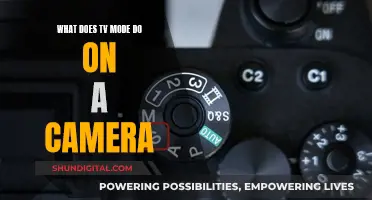
Connecting multiple USB cameras to a computer is possible, but the number of cameras that can be supported depends on several factors. The primary consideration is the available USB bandwidth, as cameras transmit a large amount of time-dependent data. While USB 3.0 and USB-C ports offer higher bandwidth than USB 2.0, connecting a USB 2.0 camera to a USB 3.0 port will cause the port to switch to USB 2.0 mode. Additionally, the number of USB controllers in the computer plays a role, as each controller typically connects to multiple USB ports, and all connected devices share the controller's bandwidth. It is recommended to connect no more than three cameras to a single USB controller to avoid exceeding the available bandwidth. To connect more cameras, additional USB controllers can be added through expansion cards, or the bandwidth usage of the cameras can be reduced by lowering the frame rate or resolution.
| Characteristics | Values |
|---|---|
| Maximum number of USB cameras that can be connected to a single computer | 127 |
| Number of USB cameras that can be accessed | 2 |
| Number of USB cameras that can be connected to a single USB controller | 3 |
| Number of USB cameras that can be connected to a single USB 3.0 port | 2 |
| Number of USB cameras that can be connected to a single USB 2.0 port | 2 |
What You'll Learn
- USB cameras can be connected to a computer via a USB hub
- The number of cameras that can be connected depends on the USB controller
- A single USB controller can typically connect to multiple USB ports
- The number of cameras that can be used simultaneously may be limited by the computer's CPU
- Using a desktop computer allows for the addition of USB controller expansion cards

USB cameras can be connected to a computer via a USB hub
USB hubs are a convenient way to connect multiple devices to a computer, but when it comes to USB cameras, the bandwidth limitation becomes a factor. USB 2.0 has a bandwidth of 480 Mbps, which is shared among all devices connected to a single USB controller. As cameras send a large amount of data, this can quickly exceed the available bandwidth. To overcome this, it's important to distribute the cameras across multiple USB controllers. In a desktop computer, this can be achieved by adding USB controller expansion cards.
Another factor to consider is the resolution and frame rate of the cameras. Higher resolutions and frame rates will require more bandwidth. For example, a camera with a resolution of 640 x 480 and a frame rate of 30 fps will use significantly more bandwidth than a camera with a lower resolution and frame rate. To connect multiple cameras, it may be necessary to reduce the frame rate or resolution.
Additionally, the type of USB port and camera can impact the number of cameras that can be connected. USB 3.0 ports have higher bandwidth than USB 2.0 ports, but when a USB 2.0 camera is connected to a USB 3.0 port, the port switches to USB 2.0 mode, limiting the bandwidth. Using USB 3.0 cameras with USB 3.0 ports can provide greater bandwidth, but they tend to be more expensive.
In summary, while it is possible to connect USB cameras to a computer via a USB hub, careful consideration must be given to bandwidth limitations, the number of USB controllers, and the resolution and frame rate of the cameras. By optimising these factors, it may be possible to connect multiple cameras successfully.
Pinhole Camera Focus: Sharp Images Explained
You may want to see also

The number of cameras that can be connected depends on the USB controller
The number of USB web cameras that can be connected to a single computer depends on several factors, including the USB controller, the resolution and frame rate of the cameras, and the specifications of the computer itself.
On a single USB bus, it is theoretically possible to connect up to 127 devices per root hub, and each controller card typically contains one or more root hubs. This means that from a purely logical and physical standpoint, connecting 12 USB cameras to a single computer is possible.
However, the actual number of cameras that can be supported depends on the available USB bandwidth. USB buses have limited transfer speeds, typically around 35 MB/s for USB 2.0. Higher-resolution cameras or cameras with higher frame rates will require more bandwidth. For example, to stream video at 640x480 resolution and 30 FPS, each camera would require around 17 MB/s of bandwidth. This means that with USB 2.0, only two cameras could stream simultaneously.
To connect more cameras, one solution is to use multiple USB controller cards occupying the PCI slots. This increases the number of available USB buses and, therefore, the total bandwidth available for the cameras. Additionally, using a powered USB hub can provide additional power to the cameras, which may be necessary when connecting multiple devices.
In summary, while it is technically possible to connect a large number of USB cameras to a single computer, the actual number supported will depend on the USB controller configuration, the camera specifications, and the computer's capabilities.
Eufy Camera Battery Life: Replace or Recharge?
You may want to see also

A single USB controller can typically connect to multiple USB ports
Each USB device can define up to 32 endpoints, but most modern USB 3.0 hosts use eXtensible Host Controller Interface (XHCI) USB controllers, which allow for a maximum of 7,906 endpoints. However, common implementations of XHCI controllers impose their own limit of 96 endpoints. This means that the maximum number of common devices that use 3 endpoints able to be attached to an Intel series 8 XHCI host controller is 32 devices.
Most host systems have just one USB controller that is integrated into the host system chipset. However, it is possible for the USB connector on your host machine to already be one or two tiers deep in the overall USB tree, as many host machines use hub chips internally to expand the number of available USB connectors.
The USB specification is limited to a maximum of 7 tiers. Therefore, there is a hard limit of 5 daisy-chained hubs (not counting the root hub). Logically, each USB host controller can support up to 127 devices, but it is unlikely that you will exceed this limit.
In summary, a single USB controller can connect to multiple USB ports, and a single USB 3.0 port has a maximum current delivery of 900 mA. By adding an active USB hub, you can provide each port on the hub with its own 900 mA of current.
Fuji's Eye-Detection Mode: Capturing Sharp Portraits with Ease
You may want to see also

The number of cameras that can be used simultaneously may be limited by the computer's CPU
The number of USB cameras that can be used at the same time may be limited by the host machine's CPU. This is because decoding and processing the video streams from multiple cameras may exceed the capabilities of the CPU, resulting in performance issues or an inability to handle all the streams simultaneously.
The processing power required to handle multiple USB camera streams can be significant, especially if the cameras are transmitting high-resolution or high-frame-rate video. Each additional camera increases the demand on the CPU, and at some point, the system may reach its processing limit.
Additionally, the software used to capture and process the video streams can also play a role. Some software may be more efficient than others in managing multiple camera inputs, and optimisation techniques can be employed to reduce the processing overhead. However, in cases where the number of cameras is very high, even efficient software may struggle to keep up.
Furthermore, other system components, such as the USB bus bandwidth, can also come into play. The USB bus has a limited data transfer rate, and if the combined data rate of all the cameras exceeds this limit, issues such as dropped frames or reduced frame rates may occur. This can be mitigated to some extent by using USB 3.0, which offers higher bandwidth than USB 2.0, or by employing video compression techniques to reduce the data rate.
In summary, while it is technically possible to connect a large number of USB cameras to a single computer, practical considerations such as CPU processing power, software efficiency, and USB bus bandwidth may limit the number of cameras that can be effectively utilised simultaneously.
Zuckerberg's Camera: Covered or Uncovered?
You may want to see also

Using a desktop computer allows for the addition of USB controller expansion cards
The number of USB cameras that can be connected to a single computer depends on several factors, including the computer's specifications, the USB standard, and the camera resolution and frame rate. While it may be possible to physically connect multiple cameras via USB ports or hubs, the main challenge lies in handling the video streams and ensuring sufficient bandwidth.
- PCIe USB 3.0 Card 7 Port: This expansion card provides seven USB 3.0 ports and is compatible with Windows and MAC OS. It offers a data transfer rate of up to 5 Gbps.
- Sonnet Allegro Pro 4-Port USB 3.2 Gen 2 Type-A PCIe Card: This card adds four 10 Gb/s USB 3.2 Gen 2 ports to your computer, with a dedicated controller and support for data transfers up to 800 MB/s.
- StarTech 7-Port USB 3.0 PCI Express 2.0 x1 Card: This card offers six external USB 3.0 Type-A ports and one internal USB 3.0 Type-A port, connecting through a PCI Express 2.0 x1 host interface.
- ASUS Hyper M.2 X16 PCIe 3.0 X4 Expansion Card: While not exclusively a USB expansion card, this option provides four NVMe M.2 slots and supports high-speed data transfer, which can be beneficial for connecting multiple USB cameras.
- StarTech 4-Port SuperSpeed USB 3.0 PCIe Card: This expansion card adds four USB 3.0 ports and includes a SATA power connector for enhanced stability, making it suitable for multi-camera setups.
By installing one or more of these expansion cards, you can significantly increase the number of USB ports available on your desktop computer, allowing for the connection of multiple web cameras. However, it is important to consider the power requirements and bandwidth limitations to ensure optimal performance when using multiple cameras simultaneously.
Olympus Cameras: Made in Japan?
You may want to see also
Frequently asked questions
It is possible to connect 127 USB devices to a single host, and each controller card will contain one or more root hubs. However, the number of cameras that can be used simultaneously is limited by the USB bandwidth and the processing power of the computer. For example, a USB 2.0 bus can deliver around 35 MB/s, which is sufficient for two 640x480 cameras at 30 FPS but not for three. Using USB 3.0 or USB-C ports and MJPEG compression can increase the number of cameras that can be used simultaneously.
The number of cameras that can be connected depends on the available USB controllers, the resolution and frame rate of the cameras, and the processing power of the computer. Each USB controller can typically support up to three cameras, and USB 3.0 or USB-C ports provide more bandwidth than USB 2.0. Higher resolution and frame rate cameras will use more bandwidth, and more powerful computers can handle more cameras.
To connect multiple USB cameras, ensure that no single USB controller is handling more than three cameras. This can be achieved by using a combination of the computer's built-in USB ports and USB hubs, and by adding USB controller expansion cards if necessary. Software such as vMix can be used to manage and view the camera feeds.







